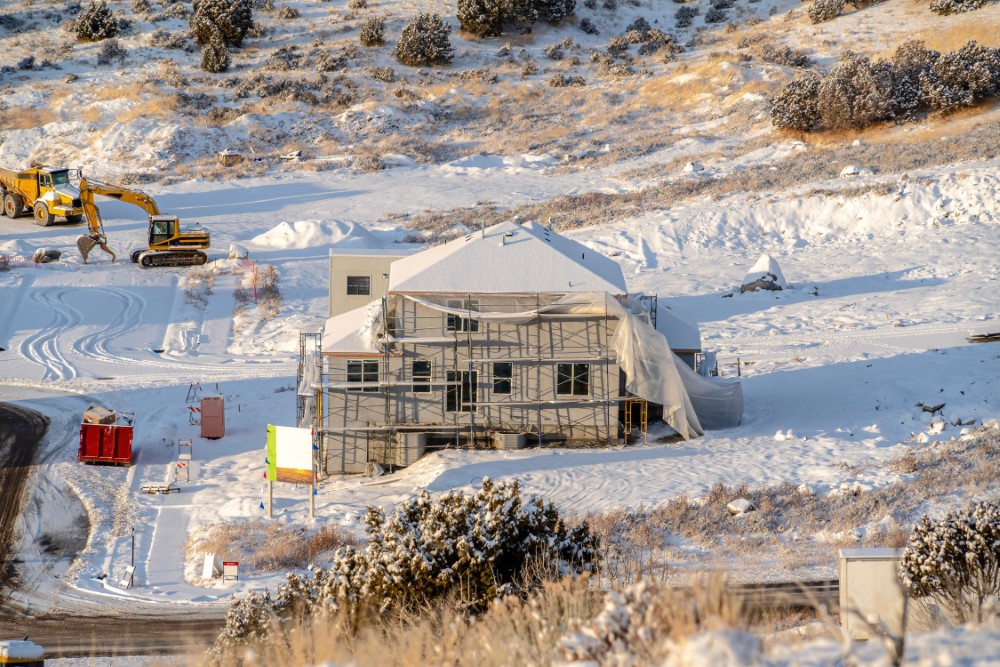Concrete is a versatile and durable construction material, but it is also a complex mixture that requires specific conditions to set and cure properly. One of the most important factors to consider when pouring concrete is the temperature. Cold weather can affect the concrete’s setting and curing process, leading to weaker, less durable concrete.
Cold weather can cause several problems when pouring concrete, such as slowing down the setting and curing process, increasing the risk of cracking and other forms of damage, and making it more difficult to maintain the proper consistency of the concrete mixture.
Minimum Temperature Requirements for Pouring Concrete
Pouring concrete in cold weather can be a tricky task, as the low or freezing temperatures can negatively impact the curing process. To ensure the strength and durability of the final product, certain minimum temperature requirements must be met.
The American Concrete Institute (ACI) recommends a minimum temperature of 50 degrees Fahrenheit (10 degrees Celsius) for both the air and concrete when pouring. This is to ensure that the concrete can properly hydrate and reach its required strength.
However, in extremely cold weather conditions, it may be necessary to use insulating blankets or heating devices to maintain the minimum temperature requirements. Additionally, it is important to consider the wind chill factor, as the wind can greatly decrease the temperature and cause the concrete to freeze.
By paying close attention to the temperature and taking appropriate measures, builders can ensure that their concrete pour will result in a strong and durable structure. Proper temperature monitoring is essential to ensure that the concrete is poured at the right temperature and that the curing process proceeds as it should. This can be done with thermometers and temperature sensors, which can be used to measure the temperature of the concrete mixture and the surrounding air.
Effects of Cold Weather on Concrete Curing
Concrete curing is a crucial process that determines the strength and durability of the final product. However, pouring the concrete mix in cold weather can have a significant impact on the curing process, leading to weaker and less durable concrete.
One of the major effects of cold weather on concrete curing is that it slows down the hydration process. Hydration is the chemical reaction between cement and water that leads to the hardening of concrete. In cold temperatures, this process is slowed down, which can result in incomplete hydration and weaker concrete.
Another effect of cold weather on concrete curing is the potential for freezing. If the water in the concrete mix freezes, it can lead to the formation of ice crystals that can cause cracking and weaken the structure of the concrete. This is why it is extremely important to ensure that the temperature of the concrete and the surrounding air is above the minimum.
To prevent these negative effects of cold weather on concrete curing, builders must take appropriate measures such as using insulating blankets or heating devices to maintain the minimum temperature requirements and also using a type of cement that sets more slowly. By paying close attention to the weather conditions and adjusting accordingly, builders can ensure that their concrete pour will result in a strong and durable structure.
Insulation and Heating Methods for Cold Weather Concrete Pouring
To maintain the necessary temperature for proper concrete curing the use of appropriate insulation and heating methods is recommended.
Insulated Blankets
One common insulation method is the use of insulated blankets or covers. These can be wrapped around the concrete forms to help maintain the temperature of the concrete. Additionally, using insulated hoses and pumps can also help keep the concrete warm as it is transported to the pour site.
Heating Devices
Another method is the use of heating devices, such as electric heating blankets or hot water systems. These can be used to heat the concrete mixture, as well as the air and surfaces around the pour site. Using these methods can help keep the concrete at the necessary temperature and prevent freezing during the curing process.
Admixtures
The use of concrete admixtures that are designed to accelerate setting time, reduce water requirements and enhance workability in cold weather.
Using a combination of insulation and heating methods can help ensure that the concrete is poured at the right temperature and that the curing process proceeds as it should, resulting in a strong and durable final product.
Admixtures and Accelerators for Cold Weather Concrete Pouring
Admixtures and accelerators are special ingredients that can be added to concrete to improve its performance in cold weather. They can help to speed up the setting time and hardening process of concrete, making it possible to pour and cure concrete in colder temperatures.
One type of admixture is an air-entraining agent, which helps to create small air bubbles within the concrete. This improves the concrete’s ability to resist freezing and thawing cycles, making it more durable in cold weather.
Another type of admixture is a set accelerator, which speeds up the setting time of the concrete. This allows the concrete to harden more quickly, reducing the risk of freezing and cracking.
Calcium chloride is a common accelerator that is added to the concrete mixture to accelerate the setting time, and this can be used as an alternative to heat to speed up the curing process.
Proper Curing Techniques for Cold Weather Concrete Pouring
Proper curing is essential for ensuring that concrete reaches its full strength and durability, regardless of the weather conditions. However, in cold weather, extra care must be taken to ensure that the curing process proceeds as it should.
One technique for curing concrete in cold weather is to keep it moist. This can be done by covering the concrete with a curing blanket or plastic sheeting, which helps to trap moisture and prevent evaporation. It’s also important to keep the concrete covered for at least the first three days, as this is when the majority of the hydration process occurs.
Another technique is to use insulated blankets or heating devices to maintain the minimum temperature requirements for curing.
Safety Precautions for Cold Weather Concrete Pouring
Cold-weather concrete pouring can pose some significant safety risks, not just for the workers but also for the final product. To ensure the safety and quality of the pour, it is important to take the necessary precautions.
One important measure is to monitor the weather conditions and adjust the pouring schedule accordingly. If the temperature drops below the recommended minimum, it may be necessary to delay the pour until conditions improve.
Another safety precaution is to provide proper training to workers on the use of equipment, such as insulated blankets, heating devices, and other protective gear, to ensure their safety and the safety of others.
It is also important to provide proper slip-resistant footwear, as wet concrete can make the surface slippery, and also provide hand warmers to protect workers from the cold.
Scheduling Concrete Pours in Cold Weather Conditions
Scheduling concrete pours in cold weather conditions can be a tricky task, but with the right planning, it is possible to ensure the quality and longevity of the final product. An important factor to consider is the wind chill factor, as the wind can greatly decrease the temperature and cause the concrete to freeze. It is crucial to choose a day with minimal wind to minimize the risk of freezing.
Another factor to consider is the timing of the pour. It is best to pour concrete in the early morning or late afternoon when temperatures are typically at their highest.
Importance of Communication and Planning for Cold-Weather Concrete Pouring
Effective communication and planning play a vital role in ensuring that a cold-weather concrete pour is successful. When all parties involved are on the same page, it helps to minimize the risk of delays, accidents, and other complications.
This includes knowing when the pour will take place, how long it will last, and what the backup plan is in case of inclement weather. By having a clear schedule, everyone is aware of their responsibilities and can plan accordingly.
Having a clear understanding of the equipment and materials needed for the pour is also crucial. By knowing what equipment is needed, the contractor can ensure that everything is on-site and ready to go before the pour begins.
Proper communication and planning also mean that the client is kept informed of the schedule and any potential delays or changes that may occur. This helps to ensure that the client’s expectations are met and that the project is completed on time and within budget.
Conclusion
Cold-weather concrete pouring requires proper temperature control and planning to ensure the success of the pour. Proper temperature monitoring, insulation, and heating methods, admixtures and accelerators, proper curing techniques, safety precautions, and effective scheduling and communication are all important aspects to consider when pouring concrete in cold weather.
Proper temperature control and planning are essential for ensuring the strength and durability of the concrete and for ensuring the safety of the workers. It is important to take all necessary precautions to protect the concrete and the workers from cold weather conditions.
If you have any doubts or concerns about pouring concrete in cold weather, it is best to consult with a professional. Milliken Corporation can advise you on the best practices and equipment to use, and ensure that the pour is completed safely and successfully. If you are looking for professional concrete services in Milton, TN, we would be happy to help!

